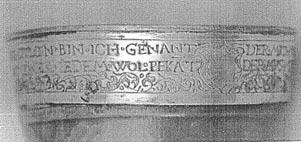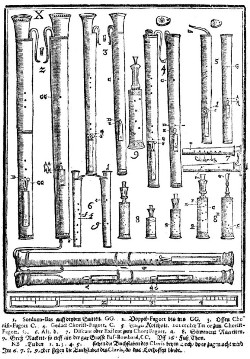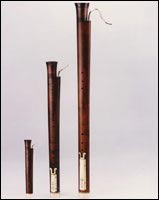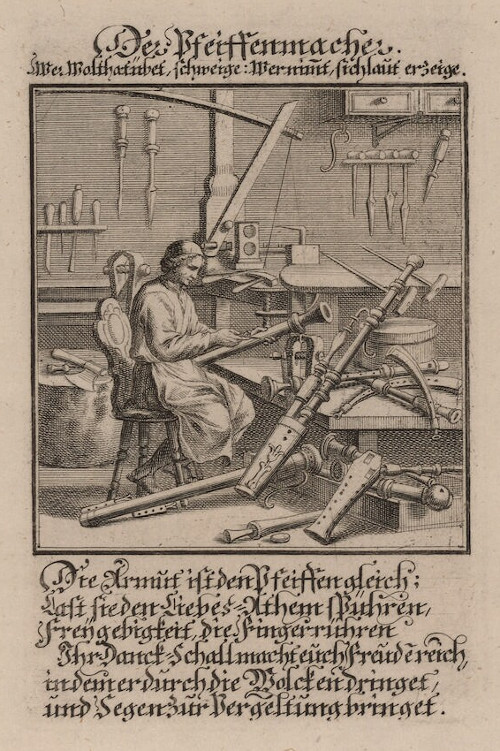DER DULCIAN BIN ICH GENANT
NIT EINEM IEDEM WOL PEKÄT [pekant]
DER MICH WIL RECHT PFEIFEN
DER MUS MICH WOL LERNE GREIFEN(The Dulcian am I called
Not well known to everyone
Whosoever will play me correctly
Must learn well how to finger me)(Inscription engraved on the bell of a dulcian
from the Vienna collection. Kilby 105).
The Dulcian
Dutch: fagotGerman: Dulzian
Italian: fagotto
French: basson
Spanish: bajón, bajoncillo
Classification and Etymology
The name dulcian (from the Latin dulcis = "soft, sweet," referring to the instrument's more subdued tone quality) is commonly used for the original version of the instrument in one piece, as opposed to the later type in joints, called bassoon. It should not be confused with the "dolzaina," a special kind of shawm, rather for indoor-playing (see "The shawm"). The term "fagot," originated in 14th-century France, derives from faggot, meaning a bundle of sticks (see also below "Phagotum"). It is also the name of a dance by Phalèse (1549) and Susato (1551; see below sound-example Susato).
The term "dulcian" denotes also a soft-toned organ reed stop in a variety of forms (Contra Dulcian, Dulzianregal or Holzdulzian – German, probably with wooden resonators), usually in 8' or 16' pitch.
The name curtal (or double curtall, curtoll, corthol) is used in England from the late sixteenth century to the early 18th for both the dulcian and the bassoon.Anthony Baines states in his Woodwind Instruments and their History (London 1957, 263) that like bombarde (the bass instrument of the shawm-family), the English name curtall is borrowed from artillery; curtal, also double curtall, had previously denoted a type of short-barrelled cannon. But the name appeared already in 1559 in Venice in the manufacture of "bassoni curti" by the renowned Bassano-family, which means 'short' (from Latin curtus); compared to the large pommers, as the bore of these instruments is doubled back in itself. See Maggie Kilbey, Curtal, Dulcian, Bajón: A History of the Precursor to the Bassoon (Saint Albans: Maggie Kilbey, 2002), 33. It is a corruption of the German Kortholt (literally: "short wood"), a generic term for double-reed instruments with bores doubled back in themselves. Praetorius (1619/20) illustrates it with a wind cap over the double-reed; see also the courtaut in Mersenne's Harmonie Universelle (1636–1637).
The History of the Dulcian
The obscure, early history of the dulcian is already evident from the ambiguities of its terminology even though visual iconographic sources are to some degree more trustworthy than written documents. In general, two successive versions of the dulcian can be distinguished from one another: the earlier, one-piece version, used up to beginning of the 18th century (in Spain until the early 20th century) was called the "dulcian." Later it evolved into the "bassoon," a similar instrument consisting of four joints.
We have learned in the shawm-section that musicians desired to extend the range of wind band instruments into the bass register which encouraged the development of a separate family of instruments. There were various sizes of shawms, the principal double-reed instrument, bombardes or pommers, from the alto up to the "Gross Bass Pommer."

See Kilby, 105.
Even thought the Gross Bass was appreciated for its rich, sonorous tone, its considerable length, up to 3 meters, made it too difficult to handle and play despite the four keys of its extension holes. However, instrument builders discovered that by doubling of the bore back to itself on the same block of wood it became far easier to handle. This technical device was to some degree already known from the trombone and Phagotum,For details to the Phagotum see Francis W. Galpin, "The Romance of the Phagotum," Proceedings of the Musical Association LXVII (1940–1941), 57–72. an unusual and complex windcap instrument from the early sixteenth century.

Syntagma Musicum II.2, 1620.Besides the various sizes of the dulcian-family there are also special forms depicted and named, like "racketts" and a "kortholt" (from German: kurzes Holz = "short wood").
-
Master of the Twelve Apostles
c. 1530–1340
98 x 138 cm.
Pinacoteca Nazionale, Ferrara
This pastoral scene is taken from the Ancient Testament (Genesis 29, 1-10) when Jacob, talking with three shepherds at a well, met Rachel the first time. At the left side of the bottom lies a Phagotum as it was invented by Afranio Ambrogio, probably the only appearance of this enigmatic instrument in painting.
The Phagotum was invented by canon/capitular Afranio Ambrogio degli Albonesi, a talented musician and collector of musical instruments. Albonesi demonstrated his new instrument at the court of Mantua in 1532. His nephew, Theseo Ambrogio, gave a first-hand account of it in his book, Introductio in Chaldaicam linguam, together with two illustrations (fig. 1).
The Phagotum's device was applied to the dulcian by boring two parallel tubes in one block of wood and connecting them by a short windway. This technique was later used for the medieval trumpet, but its application to a woodwind instrument facilitated finger placing since the holes were within easy reach. In his Harmonie Universelle 1630, Mersenne gave the earliest notice of the Phagotum. Since then, the Phagotum was traditionally considered to have been the earliest ancestor of the dulcian and the later bassoon on the strength of its name, whose Italian form (fagotto) is still used for today's bassoon in the Italian, German and Dutch language.
The first to mention the dulcian was the Italian-Austrian priest, composer and music theorist Lodovico Zacconi in his Prattica di musica (Venice 1592). Zacconi noted a "Fagotto chorista" with the range of C-b. This term was also applied to other instruments in order to indicate a particular register or pitch level, but, according to musicologist Curt Sachs, the term "chorista" had been derived from the instrument's customary function of supporting the bass in choral music.
As it is later evident from Michael Praetorius' detailed descriptions and drawings of "Fagotten" or "Dolcianen" in his Syntagma Musicum II (fig. 2). 1 and 2 ("De Organographia" 1619, and "Theatrum Instrumentorum," 1620), the dulcian was built in various sizes (discant, alto, basset or tenor, "Bass Sordun," "Chorist"- and "Doppel-Fagott"). But the "Choristfagott" (lowest note C) soon established itself as the most useful member of the dulcian-family bass instrument. It was loud enough for outdoor music (including dance music) played by town waits, but rich and warm enough for accompaniment in chamber and choral music.


It has a total length of 1,8 m and was made of one large piece of wood, unusual for the manufacture of a large bass instrument.
Below is a chart of the principal sorts of dulcians (called with the German term "Fagott") described and depicted by Michael Praetorius, together with their compasses.Maggie Kilbey, Curtal, Dulcian, Bajón: A History of the Precursor to the Bassoon (Saint Albans: Maggie Kilbey, 2002), 113f.; Will Jansen, The Bassoon: Its History, Construction, Makers, Players, and Music, 5 vols. (Buren, 1978–1981), Vol. 1, 59.
| German term (Praetorius) | English term | compass |
| 1. Discantfagott | Treble-Fagott | g' – c'' |
| 2. Altfagott | Alto | c – g' |
| 3. Fagott Piccolo oder Singel Kortholt. Basset oder Tenor zum Chorist-Fagott. G |
Single curtal. Basset or tenor to the Chorist-Fagott. G | G – g' |
| 4. Offen oder Gedackt Chorist- Fagott oder Doppel Kortholt |
Open or Covered Chorist-Fagott or double curtal |
C – g' |
| 5. Doppelfagott: Quartfagott Quintfagott |
quart-Fagott (quartbass) quint-Fagott (greatbass) |
G – a F - g |
From ItalyIn Venice the famous wind instrument workshop of the Bassano-family who were among the first to make the dulcian. the dulcian soon spread to the principal musical centers in Europe including EnglandAt the Royal Court several members of the Bassano-family worked as sackbut players and wind instrument makers and numerous English town wait bands. and the German speaking countries where all sizes of dulcians were in use and where good part of references to the greatbass sizes (Choristfagott, Doppel- or Quint- resp. Quartfagott) are found. This is also evident from the considerable number of sixteenth- and seventeenth-century dulcians found in museums of German speaking cities, above all Vienna and Berlin, but also Augsburg, Linz, Nuremberg, Salzburg, Brunswick, Sondershausen, Leipzig or Dresden.

One of the leading woodwind instrument makers from the late seventeenth century was Johann Christoph Denner (1655–1707), born in Leipzig and later moved to Nuremberg, the center of instrument making in the sixteenth and seventeenth century. In Nuremberg he established a successful workshop continued by his sons Johann David and Jakob Denner. Johann Christoph Denner is the only maker known to have constructed both dulcians and bassoons (fig. 3) and is said to have invented the clarinet.
The use of the dulcian by the German Pfeifergericht (see also "The Shawm") at the ceremonial opening of the Frankfurt fair persisted well into the 18th century.
In Spain, the dulcian/curtal was widespread. The bass was known there as the bajón and the smaller sizes as bajoncillos. Spanish forms have a number of features that distinguish them from other dulcians, for example, a metal lining at the top of the downbore, brass bands around the instrument to support the key mechanisms, a decorative brass bell crown and at times a brass band around the base of the bell. The earliest reference of bajones dates from 1530, but they were still made after the jointed bassoon (fagot) was introduced in the late seventeenth century. The fact that all known iconographic sources have an ecclesiastical setting indicates that bajones or bajoncillos were primarily played in church music, but there is also some evidence of secular use.

Juan Andres Ricci
1639
Museum of Montserrat, Barcelona, Spain
The musicians (probably in church service), visible at the bottom of the painting, accompany the singers with (f.l.t.r.) a cornett, two larger sizes of shawms and a dulcian or bajón.
